Corten sculptures - conservators are playing catch-up with preservation techniques
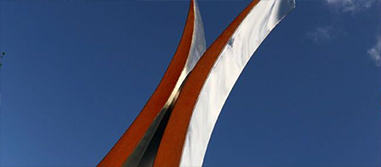 As Corten becomes increasingly popular for use in outdoor sculptures, conservators are playing catch-up with their preservation techniques. Peter Elliott of Nottingham-based All Steel Fabrications Ltd, specialists in the collaboration, fabrication and installation of Corten steel and other stainless steel sculptures, offers this valuable insight.
As Corten becomes increasingly popular for use in outdoor sculptures, conservators are playing catch-up with their preservation techniques. Peter Elliott of Nottingham-based All Steel Fabrications Ltd, specialists in the collaboration, fabrication and installation of Corten steel and other stainless steel sculptures, offers this valuable insight.
The way in which Corten is used throughout a sculpture is conditional on its production form, i.e. plate rod, flats or structural sections.
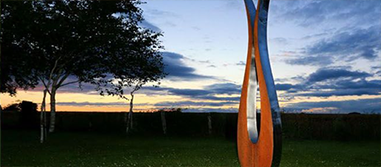 Ordinary steel surfaces can be treated after the work has been completed and sculptors have used everything from powder coating through to paint and acid etching.
Ordinary steel surfaces can be treated after the work has been completed and sculptors have used everything from powder coating through to paint and acid etching.
Corten, on the other hand, is normally used out of the mill because of the rough, purple/brown surface that is eventually revealed when its rusting stabilises. That means that most Corten sculpture is found outdoors. It also means that, in fabricating the sculptures, we must take a great deal of care when we are welding and grinding, and when mixing with other materials. When we don’t, the conservators eventually get interested, although British sculptors are amused by the idea of needing to conserve an essentially found material.
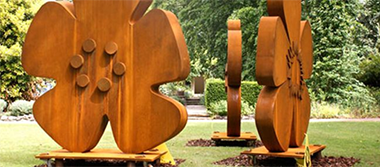 History Of Corten
History Of Corten
In the 1930s, the United States Steel Corporation developed Corten, primarily for use in railway coal wagons. The controlled corrosion that is a feature of the material was a welcome by-product of the tough steel which can withstand the rigours of America's marshalling yards and collieries. Because of its inherent toughness, weathering steel (the generic name for Corten, along with weather-resisting steel) is still used extensively for containers.
The civil engineering applications that appeared in the early 1960s made direct use of Corten’s improved resistance to corrosion, and it would not be long before applications in architecture would become apparent.
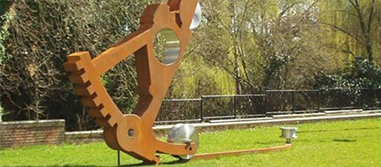 Corten gets its properties from a careful manipulation of the alloying elements added to steels during the production process. All steel produced by the primary route (in other words, from iron ore as opposed to scrap) comes into being when the iron is smelted in blast furnaces and is reduced in a converter. The carbon content is lowered and the resulting iron, now steel, is less brittle and has a higher capacity for loading than before.
Corten gets its properties from a careful manipulation of the alloying elements added to steels during the production process. All steel produced by the primary route (in other words, from iron ore as opposed to scrap) comes into being when the iron is smelted in blast furnaces and is reduced in a converter. The carbon content is lowered and the resulting iron, now steel, is less brittle and has a higher capacity for loading than before.
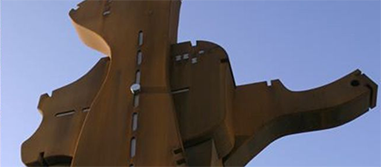 Other material is commonly added during the process. Stainless steel has added chromium and molybdenum, for example, and weathering steel has a combination of chromium, copper, silicon and phosphorus, the amounts of which are dependent on the exact attributes required.
Other material is commonly added during the process. Stainless steel has added chromium and molybdenum, for example, and weathering steel has a combination of chromium, copper, silicon and phosphorus, the amounts of which are dependent on the exact attributes required.
Weather-resistant steelworks by controlling the rate at which oxygen in the atmosphere can react with the surface of the metal. Iron and steel both rust in the presence of air and water, resulting in corrosion (rust/iron oxide). Non-weathering resistant steels have a relatively porous oxide layer, which can hold moisture and promote further corrosion. After a certain time (dependent on conditions), this rust layer will delaminate from the surface of the metal, exposing the surface and causing more damage. Rusting rates seen on a graph would appear as a series of curves approximating to a straight line.
For more examples of Corten and other steel sculptors visit www.allsteelsculpture.com















